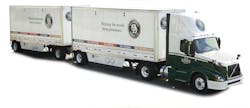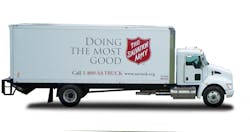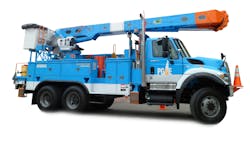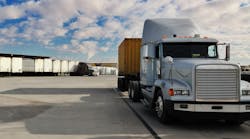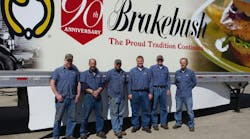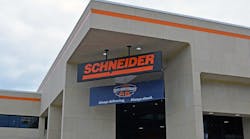On the following pages are revealed the three winners of our 12th Annual Fleet of the Year Awards—one each from the for-hire, private and vocational segments of trucking.
Fleet Owner honors these outstanding fleets for a specific type of excellence. In selecting our winners, the editors of Fleet Owner seek above all to recognize fleets whose executives have concretely applied innovative thinking to substantially enhance key aspects of their respective trucking operations.
The operations of these fleets vary and the challenges they face differ. Yet all three of our honorees have notched notable victories. They have done so not by being blindly led by conventional wisdom let alone by what might have worked in the past. Rather, these fleets have advanced on numerous fronts guided by leaders with minds open wide to new approaches—and with the ability to put squarely into practice the solutions that truly smart thinking revealed.
Nominations are not sought for these honors. Nor are they linked to any industry association or influenced by any outside group. Instead, candidates are identified and researched over the course of the calendar year by Fleet Owner’s editors, who then determine the Fleet of the Year winners and runners-up.
Indeed, each of our honorees exemplifies the innovative leadership that we are proud to salute once more with our exclusive Fleet of the Year Awards.
The winners are...
For-Hire
Old Dominion Freight Line
Thomasville, NC
Boasting one of the industry’s lowest operating ratios and strong financial performance overall, Old Dominion Freight Line (ODFL) keeps out front by pumping innovation into its fleet at every turn. The company is rightly proud of its heritage, having started out almost 80 years ago as an LTL pioneer. But management that keeps a keenly innovative eye on the here and now is ensuring the fleet’s continued success in today’s broad trucking marketplace.
ODFL serves over 48,000 points through 220 service centers in 48 states with a fleet of 6,400 tractors and over 24,000 trailers, including 17,750 28-ft. pups.
“Old Dominion’s mission statement calls for innovative solutions and that is the fleet’s defining principle,” states Jim Raynor, vice president of equipment and maintenance. “Our objective is to provide safe, clean, dependable equipment in a timely fashion at the lowest possible cost to support Old Dominion’s operations.”
Among its signature innovations, the carrier employs a team dedicated to analyzing data that flies in at five-minute intervals via onboard computers. That information helps enhance driver training and is credited with cutting fuel use by nearly 2% thus far.
Since 2010, according to Raynor, telematics data has been leveraged to weigh the impact of new technology on fuel efficiency, including TPMS on trailers and dollies, speed limiters, low-rolling resistance tires, and spec’ing a tighter ‘gap’ between tractor and trailer.
Other recent innovations involve the greening of tractor and trailer specs. Raynor advises that outfitting new trailers and retrofitting those less than 10 years old with side skirts has helped deliver a 2% boost in mpg. ODFL is also installing a decking system in trailers that allows pallets to be loaded on beams so they are not directly on other freight. “It protects the customer’s goods and fully utilizes the trailer,” Raynor notes.
On the shop side, he points out that the fleet “ensures better quality and cost control by doing as much in-house as possible. We’re now at 75%—pretty much covering everything except engine overhauls.” That includes a sand-blast paint booth, “as the back of trailers often need refinishing to protect the image of the fleet.”
ODFL has 35 shops as well as 11 mobile-maintenance vehicles that are dispatched to and from small facilities. Some 500 techs along with 24 office staff handle the work.
“We have our own internal trainers, for which we’ve been recognized by ASE,” Raynor says. “Our training investment is unparalleled compared to our competition.”
As for finding and keeping techs, he notes that ODFL “links pay ‘bumps’ to training attained” and that “people like to work for a winner, and they can see by our operating ratio that is what we are.”
As for fleet power, Raynor points out that the tractor mix is 70% linehaul and 30% P&D. “Most are single drives and primarily Freightliners, with Volvo accounting for the next largest group. We don’t know yet which of the new engines will work best, so we run a mix of engine makes as we measure their performance.”
Recognizing that going green can save green in many ways, the carrier recently opened its first LEED-certified service facility, which it expects will cut energy use by almost 20%.
On top of all that, ODFL reported a year-over-year increase in revenue of 12% as well as net income growth of 17.8% for this year’s third quarter. What’s more, its on-time delivery rate stands at 99% and cargo claims ratio at 0.31%. And it is running with an enviable 84.1% operating ratio—compared to 85.3% a year ago.
“Our business is really pretty simple,” Raynor sums up. “Move the customer’s shipment. But it takes a lot of people working together to make that happen safely and cost-effectively.”
Runner-up
Dupré Logistics
Lafayette, LA
Asset-based and 3PL provider’s combined driver recruiting, monitoring and training program has delivered an excellent safety record and very low driver turnover.
Private
The Salvation Army USW
Long Beach, CA
The Salvation Army is well-recognized for its long history of providing free rehabilitation programs to alcoholics, drug addicts and others coping with serious problems. This charitable effort is supported by the sale of donated items at its retail stores. The revenues from those sales fund the Army’s global network of Adult Rehabilitation Centers (ARCs).
Those ARCs are all about people helping others in need. But the entire effort would come to a screeching halt without trucks. In the U.S., the Salvation Army fields regional fleets of trucks that pick up clothing, appliances, furniture and household items directly from donors.
The Salvation Army USA Western Territory (SA-USW), based in Long Beach, spans California, Oregon and Washington, extends east to Colorado, and covers Hawaii as well. Providing P&D service in this region are some 250 Class 6 straight trucks and 20 Class 8 tractors operating out of 22 locations.
“Each of our trucks makes about 30 stops a day,” advises Henry Filoteo, SA-USW’s territorial director of production. “If we have a truck that breaks down after the first three stops, we have to call 27 other donors and tell them we can’t pick up their donation. Not only is that a huge inconvenience for them, it’s likely we’ll lose a lot of donations, and donors may tell family and friends that you can’t count on the Salvation Army to pick up when they say they would.”
To help avoid those issues altogether, the SA-USW fleet has been innovatively recast over the past few years to both increase its vehicle utilization and driver productivity as well as to cut operating costs.
According to Filoteo, the biggest change came by nearly halving the fleet size. Back in 2009, SA-USW ran 425 trucks—now it fields just 270. Yet, he reports that the smaller fleet is delivering more goods.
The SA-USW fleet had consisted of trucks of varying vintage built by five different OEMs. And locations that were running trucks prone to breaking down kept spares on hand. When the fleet began buying new trucks, at one location it traded out 100 trucks in a fell swoop.
Equipment upgrading has included replacing 22-ft. box vans with 26-footers to gain more payload. In addition, SA-USW has opted for a new material roll-off system that it credits with improving unloading time by 40%.
“All told,” Filoteo remarks, “the new equipment carries more cargo, is more reliable, less expensive to maintain, and lets us make quicker turns—so our fleet count is down, but our productivity is up.”
The maintenance savings alone from modernizing the fleet is substantial. “For example,” he advises, “at four locations served by a group of older trucks, maintenance costs totaled $440,000. Within a year after those trucks were replaced by new ones, that figure dropped to $159,000.”
Filoteo says that SA-USW, which is self-insured, has also realized a safety dividend from buying new as well as by going with one truck make. “We’ve seen our accident rate decrease by 75% since upgrading the fleet,” he explains. “Before we standardized on Kenworth T270 and K270/370 trucks, our drivers were rotating through various vehicles. Now, drivers at a location are all in a ‘standard’ truck that they each know exactly how to operate.”
SA-USW also determined it should get with one maintenance-service provider. “We found the work being done at two locations under contract by Kenworth PremierCare cut maintenance costs about 15%,” says Filoteo.
“As more locations have been put on, the savings have been consistent,” he adds. “And quality PM care makes it much less likely one of our trucks will miss a scheduled pickup.”
Runner-up
Meijer
Grand Rapids, MI
Midwestern retailer now operates one of the largest all-clean diesel fleets in North America, reducing its carbon footprint by nearly 60% in just three years.
Vocational
Pacific Gas & Electric Co.
San Francisco, CA
While the fleet operation supporting Pacific Gas and Electric Co. (PG&E), one of the nation’s largest public utilities, is nothing if not huge and complex, its mission can be summed up as ensuring efficiency and advancing sustainability. From there, things get complicated and therefore innovation at work must be more the rule than the exception, according to Dave Meisel, senior director of transportation & aviation services.
PG&E provides natural gas and electric service to some 15 million people across 70,000 sq. mi of the Golden State, from Eureka in the north down to Bakersfield and from the Pacific east up into the Sierra Nevada. “Running from zero elevation, across deserts and up mountains, our fleet encounters every climate and topography in California. That’s why,” Meisel says only half-jokingly, “if it has wheels on it, we probably have one.”
PG&E fields close to 14,000 vehicles comprised of 156 distinct sets of specs. That’s not counting the jet and fixed-wing aircraft and ’copters that make up the fleet’s ‘air wing.’
“We run a lot of complicated vehicles, and their maintenance and repair needs are pretty broad,” says Meisel. “And because we run the largest utility fleet in the country and do so in California, we are both required and expected to be as environmentally sustainable as possible.”
Indeed, PG&E currently runs some 3,400 green vehicles, powered by natural gas, hybrid drives and electricity.
“When we look at specs, especially for alternative-fuel vehicles, our premise is that first and foremost they must meet the needs of our operation,” Meisel points out. “Then we look at their environmental contribution and cost of operation.
“From there,” he continues, “we do a trade-off analysis of the environmental impact versus operational cost.”
Once PG&E decides on a spec, it starts with a clean sheet. “One of the most innovative things we’ve done was to develop the hybrid-electric bucket truck,” Meisel relates. “That began with a discussion on how those trucks were idling six to seven hours a day. By working with Altec, we electrified all our Ford F-550 units and cut idling to zero.”
Meisel says PG&E “ends up saving more by going green. We paid a premium...but our analysis showed that we’d save so much fuel that payback would come in just three years.”
The utility has also invested in green infrastructure. Besides 32 CNG and LNG fueling locations, PG&E has installed more than 100 electric-vehicle charging stations and is putting in place over 30 more.
Maintenance is handled by 375 technicians based at 63 facilities or assigned to 80 mobile-service vehicles. “Our outsourcing strategy is not to outsource,” Meisel advises, “except for procedures like glass and body work that we can’t cost-justify doing internally.”
PG&E is keeping techs up-to-date via its PowerPathway Clean Tech Vehicle Training Network. Comprised of educational partners who collaborate with PG&E, it provides training and educational courses to support environmentally friendly fleets.
For example, the Clean Tech program sent a PG&E master mechanic to train instructors at seven community colleges on how to deliver a repair curriculum for hybrid trucks. The colleges in turn provided training to 225 of the utility’s techs across eight regional garages in just two months.
PG&E looks beyond its own numbers to stay on top. “We routinely benchmark in several ways,” explains Meisel. “We exchange information with some of the few multi-state utilities that operate over 10,000 units and with other operations that are similar in size to us. We also contract to compare fleet metrics against a database of some 400,000 units to get an accurate comparison of our operation.”
Runner-up
Usher Transport
Louisville, KY
Bulk hauler has outfitted its entire fleet of power units and tank trailers with an array of the latest safety technologies available, including roll stability systems.

